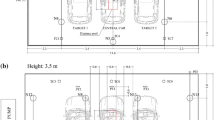Abstract
The self-extinguishing behavior of kerosene spray fire was investigated in a completely enclosed compartment with the size of 3 m × 3 m × 3.4 m. The spray was generated by locating one BETE nozzle at the center of the bottom wall. A series of spray fire videos were obtained by changing BETE nozzle type and injecting pressure. The results show that spray fire undergoes four stages: the growth stage, the quasi-steady stage, the stretch stage and the self-extinguishing stage. Consumption of large quantities of oxygen causes spray fire to first be stretched and then quench. In this process, fire base migrates away from spray region and leads to the emergence of ghosting fire. Ghosting fire promotes the instability of spray fire and large fluctuation of its height, which provides help to its self-extinguishing. With increasing the injecting pressure or the nozzle diameter, the self-extinguishing time decreases. It is found that the self-extinguishing time is approximately in inverse relation with injecting flow rate. Additionally, we also observed the occurrence of two-phase deflagration just after ignition, and it accelerates the spray fire growth and induces a larger fire height than the following quasi-steady spray fire. The deflagration turns stronger with increasing the injecting pressure.
Similar content being viewed by others
References
I. Düwel, H.W. Ge, H. Kronemayer, R. Dibble, E. Gutheil, C. Schulz, J. Wolfrum, Experimental and numerical characterization of a turbulent spray flame, Proc. Combust. Inst., 2007, 31: 2247–2255.
A.N. Karpetis, A. Gomez, An Experimental study of well-defined turbulent nonpremixed spray flames, Combust. Flame, 2000, 121: 1–23.
Y.C. Chen, S.H. Stårner, A.R. Masri, Characteristics of turbulent spray combustion in a piloted jet flame burner, Proc. Combust. Inst. 2002, 29: 625–632.
M. Mikami, S. Miyamoto, N. Kojima, Counterflow Diffusion Flame with Polydisperse Sprays, Proc. Combust. Inst. 2002, 29: 593–599.
G. Hankinson., B.J. Lowesmith, Effectiveness of area and dedicated water deluge in protecting objects impacted by crude oil/gas jet fires on offshore installations, J. Loss Prev. Process Ind., 2004, 17: 119–125.
G. Hankinson, B.J. Lowesmith, J. A Evans. and L. C. Shirvill, Jet fires involving releases of crude oil, gas and water, Trans IChemE 2007, 85(B3): 221–229.
B. J. Lowesmith, G. Hankinson, M. R. Acton and G. Chamberlain., An overview of the nature of hydrocarbon jet fire hazards in the oil and gas industry and a simplified approach to assessing the hazards, Trans IChemE, 2007, 85(B3): 207–220.
O. Sugawa, K. Kawagoe, Y. Oka, Burning behavior in a poor-ventilation compartment fire — ghosting fire, Nuclear Engineering and Design, 1991, 125(3): 347–352.
L. Audouin, J. M. Such, J.C. Malet, and C. Casselman, A real scenario for a ghosting flame, Fire Safety Science 1997, 5: 1261–1273.
Utiskul, Y. J. Quintiere, A. Rangwala, et al., Compartment fire phenomena under limited ventilation, Fire Safety Journal, 2005, 40(4): 367–390.
Author information
Authors and Affiliations
Additional information
This project was supported by National Natural Science Foundation of China (Grant No. 51276177).
Rights and permissions
About this article
Cite this article
Wang, C., Guo, J., Yan, W. et al. Self-extinguishing behavior of kerosene spray fire in a completely enclosed compartment. J. Therm. Sci. 22, 505–510 (2013). https://doi.org/10.1007/s11630-013-0655-5
Received:
Published:
Issue Date:
DOI: https://doi.org/10.1007/s11630-013-0655-5




